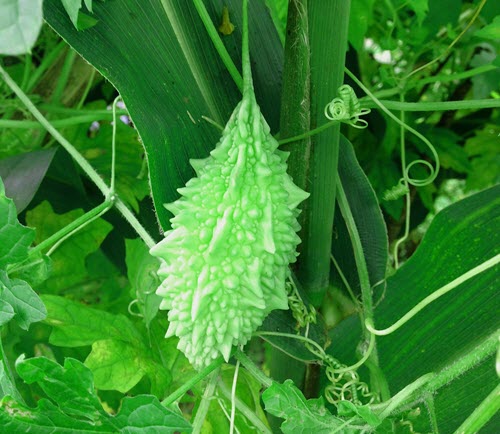Bitter Gourd or Karela as it is popularly known is a vegetable that is an excellent source of Vitamin C and Vitamin K. Its health benefits extends to lowering blood sugar levels, lowering cholesterol, and helping in digestion, but it requires an acquired taste to enjoy it. The bitter gourd plant quickly germinates from seeds and fruits practically all year round. In this post, I’ll discuss how to grow bitter gourd in pots so you can enjoy the freshest produce in abundance from your home garden.
How to Grow Bitter Gourd Plant in Pots

1. Find a warm sunny spot on your terrace.
2. Use organically rich, sandy or loamy well drained soil. A mixture of cow dung and compost will also do wonders for the plant.
3. You can use the bitter gourd seeds from any ripe bitter gourd you picked up from the vegetable market. Just make sure to use only the seeds that are fully formed. You can also use seeds from a previous crop, or buy them from your local nursery. If there is a red coating on the seeds, remove it. If necessary, you can soak the seeds overnight in water before sowing to speed up germination.
4. Make holes about half inch deep in the soil and drop the seeds into them. You can leave about 12 inches of space between two holes. Cover the holes with soil and sprinkle some water on top. Sow at least 2 seeds in a pot and use at least 2 pots for sowing the seeds.
The seeds will start to germinate within 2-3 days of sowing and flowers will start to appear in 5-6 weeks. The gourds will be ready for picking within 3 months from planting.
How to Care for Bitter Gourd Plants
1. Allow the soil to dry out before watering the seeds to prevent them from rotting. You can continue to regularly water the plant to keep the soil moist, but not soggy.
2. The Bitter gourd is a vine, so you need to set up a support structure or trellis about 6-8 feet in height for the plant to climb on.
3. Pruning is very important to get the maximum yield from the plant. 3-4 weeks after sprouting, the plant will start to develop lateral shoots. Cut off the growing tips of the branches when they are about 2-3 feet long. The plant will then start producing side branches and yield more flowers and fruits at a quicker pace.
4. If your bitter gourd plant has a lot of flowers but no fruits, it may be because pollination is not taking place in your terrace. You could encourage bees to visit your garden by planting a variety of flowering plants. But if you don’t have any flowering plants, then you’ll have to do the pollination yourself, manually.
You can do this by picking up a male flower and gently rubbing it face to face with a female flower (identified by the presence of a fat module that is shaped like a mini bitter gourd between the flower and the vine stem). Or you could use a soft brush to gently swipe over the male flower and then proceed to brush the female flower.
5. Every 3 weeks add liquid fertilizer or seaweed solution to the soil.
6. If you want bitter gourd seeds to sow for the next season, allow one gourd to ripen in the vine. It will turn yellow and when you cut open the fruit, it will reveal seeds with a gloriously red coat. Wash and dry the seeds in a shady place and store them in an air tight bag for re-use later.
Wonderful yet very simple, carryon.Goodluck.
Hi how big should my pots be ?
I am growing in a container and lots of BG have come,can i grow something else in the same container
My Bittergourd develops till 1 inch and then turn yellow.Any solution.